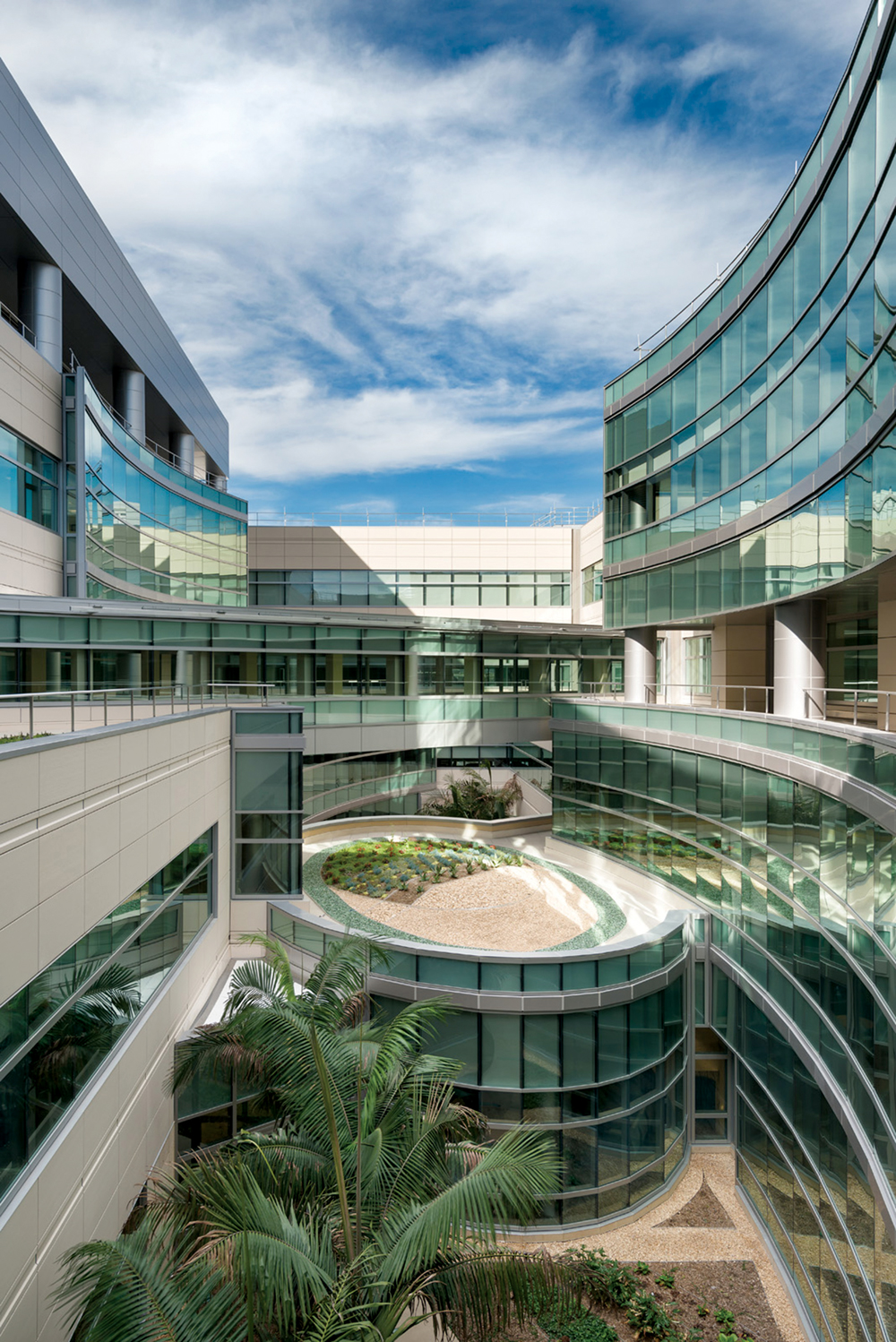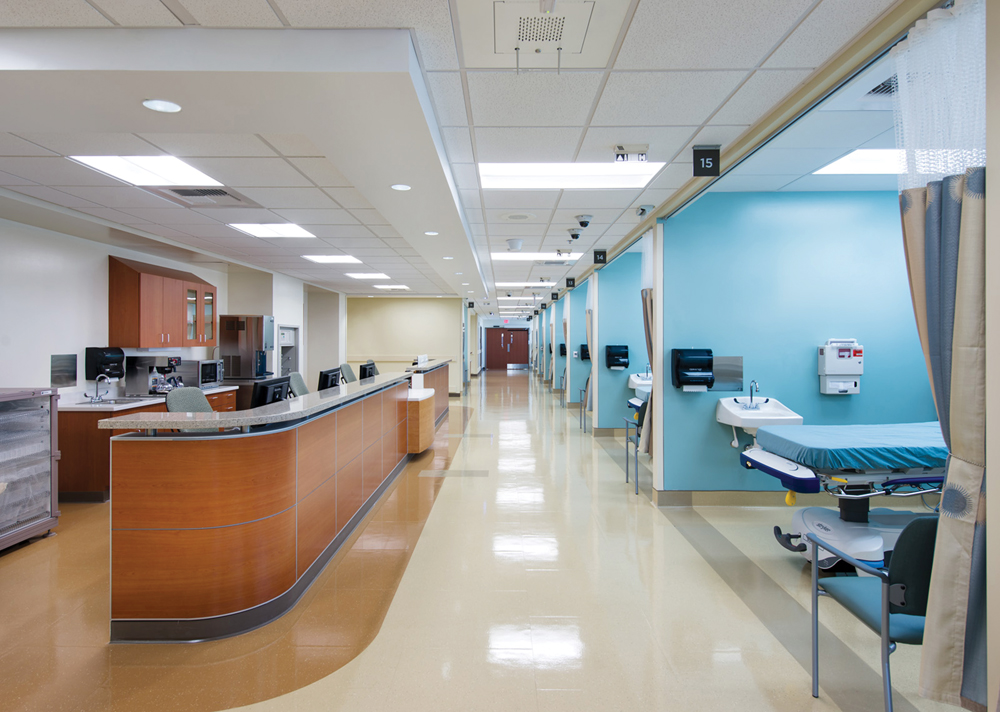In a Building Team Awards competition that was heavy with high-quality healthcare projects, including four eventual winners, the Naval Hospital at Camp Pendleton (NHCP) stood out, according to the awards judges. The jury commended the Building Team for executing an extremely large and complex program under an aggressive schedule and experimental design-build contracting method—all while beating the initial budget by nearly 19%.
“On top of that, this project has a strong environmental story,” said Building Team Awards judge Susan Heinking, AIA, NCARB, LEED AP EB O+M, Sustainability Leader and Vice President with VOA. On track for LEED Gold, the facility outperforms baseline ASHRAE energy standards by 30%, thanks to its daylight-rich interior scheme, 36,000-sf vegetated roof, and 170 kW photovoltaic solar panel array for domestic hot water.
The massive, one-million-sf campus was completed in just 34 months, a full six months ahead of the original schedule and two years faster than any previous NAVFAC hospital project. The Building Team also came in more than $100 million under budget, with less than 2% contractor-requested change orders, zero lost-time incidents, and zero rework needed due to government noncompliance.
The scope of the project entailed building a 500,000-sf hospital with 60 inpatient beds for medical surgery, labor/delivery, post-partum, and intensive care, as well as 96 procedure rooms, 205 exam rooms, and 10 operating rooms; a central utility plant with 3,100 tons of cooling and redundant utility systems; a 1,500-space parking facility; and 1,000 surface parking spaces.
PLATINUM AWARD
Project summary
Naval Hospital at Camp Pendleton
Oceanside, Calif.BUILDING TEAM
Submitting firms: Clark Construction Group, McCarthy Building Cos. (joint venture design-build contractor)
Owner: NAVFAC Southwest
Design architect: HDR Architecture
Architect of record: HKS
Interior architect: Young and Co.
Structural engineer: KPFF Consulting Engineers
Mechanical engineer: TMAD Taylor and Gaines
Electrical engineer: exp.
Civil engineer: BergerABAMGENERAL INFORMATION
Size: 1,000,000 gsf
Construction cost: $447.3 million
Construction: September 2010 to September 2013
Delivery method: Design-build
Funded through the American Recovery and Reinvestment Act of 2009, the project had to be completed in record time (by Navy standards) in order to meet the ARRA requirements. It meant the Building Team would have to compress the project schedule from the typical five- to seven-year time frame to just 40 months—a goal that was ultimately bested by six months.
To expedite the schedule and start construction early, the project team developed a phased-design approach—a first for NAVFAC. The team worked alongside the client to identify critical path activities available for early starts, and eventually divided the project into six design packages.
This approach slashed several weeks off the project schedule. For instance, by sequencing the structural package as one of the first to be reviewed and approved, the hospital’s foundation work kicked off two weeks early. And siphoning a portion of the civil design into an early package facilitated the relocation of two high-voltage transmission lines, which enabled the team to clear the way for an early start of mass grading.
BREAKTHROUGH TURNKEY PROJECT DELIVERY
In a first for the federal government, the design-build team, under a turnkey contracting method, was responsible for not only designing and building the campus, but planning, procuring, and installing all medical equipment, furniture, and artwork, as well as training the hospital staff on the equipment. From the MRI units and blood analyzers to the patient beds and operating room integration, the Building Team was responsible for all aspects of delivery: design, planning, equipment selection, procurement, installation, training, and warranties.
Under the contract, the design-build team—led by Clark Construction Group and McCarthy Building Cos., with HDR Architecture and HKS on the design side—worked hand in hand with NAVFAC to evaluate, select, and coordinate more than 20,000 pieces of equipment for the complex. Every piece of equipment was scrutinized to determine the greatest value to the client, based on life cycle cost, maintenance contracts, model options, and competitive offerings.

The massive campus was completed in just 34 months, a full six months ahead of the original schedule and two years faster than any previous NAVFAC hospital project. A pocket courtyard adds to the healing environment. Photo: LaCasse Photography
Once the design was finalized, the team worked closely with NAVFAC to understand its funding schedule, and with the equipment manufacturers to develop a procurement schedule. The goal was to delay final equipment selections to ensure the latest technology, without impacting construction or requiring rework. After the client settled on specific equipment, Clark/McCarthy secured a purchase order from the manufacturer, coordinated lead times with the construction schedule, and incorporated just-in-time delivery to the site, which eliminated the need for temporary warehousing.
5D BIM MODEL PAYS OFF
From the project’s inception, the team worked entirely in three dimensions to design and coordinate the hospital, including its civil infrastructure, building superstructure, envelope, building systems, and interior spaces.
During design development, the model helped the team accurately determine the budget and constructability. The model was linked to the project’s cost-loaded CPM schedule to produce a 5D tool (3D geometry, time, cost) that automatically adjusted when changes were made.
Using the model, the team prefabricated numerous materials and components, including mechanical systems, window and exterior framing assemblies, ductwork, piping, casework, pneumatic tube system, and electrical distribution systems.

Navy Medicine West personnel were integrated into the project team to provide valuable counsel on how to design and build the most functional spaces for hospital staff. The team used BIM to produce virtual mockups, in conjunction with physical mockups, for a half-dozen major medical spaces. The digital layouts helped coordinate all in-wall and overhead MEP and mechanical spaces, doors, and stud locations, as well as provide tools for early validation by the clinical staff. Photo: LaCasse Photography
From the successful implementation of an experimental turnkey contract method to the use of 5D BIM for advanced collaboration, the Naval Hospital at Camp Pendleton will serve as model for federal healthcare facilities delivery for years to come.
Related Stories
Cultural Facilities | Mar 31, 2015
Pratt Institute to offer first-ever degree in placemaking
As part of its new Urban Placemaking and Management degree, Pratt will offer courses on topics such as "the history and theory of public space" and the "economics of place."
Architects | Mar 30, 2015
Q+A with Arthur Gensler, and advice from his new book
"Designers need to be trained to solve their clients’ problems through design while leading their own firms to become sustainable practices," says Gensler.
Structural Materials | Mar 30, 2015
12 projects earn structural steel industry's top building award
Calatrava's soaring Innovation Science and Technology Building at Florida Polytechnic University is among the 12 projects honored by the American Institute of Steel Construction in the 2015 IDEAS² awards competition.
Cultural Facilities | Mar 30, 2015
Designs released for new entertainment center in Lubbock, Texas
Amenities of the facility include a performance venue that seats 2,220, a smaller one that seats 425, a 6,000-sf multipurpose room, and a bistro café.
Multifamily Housing | Mar 27, 2015
Bathroom fixtures get a starchitect makeover by Bjarke Ingels
This Danish starchitect elevates the toilet paper holder (and other bathroom accessories).
Architects | Mar 27, 2015
Illustrator Federico Babina explores architecture as animals
When you pay attention, the Eiffel Tower really does look like a giraffe.
Transit Facilities | Mar 25, 2015
Kengo Kuma selected to design new Paris Metro station
The new station will serve as a hub to connect Paris' northern suburbs with the core.
Green | Mar 25, 2015
WELL Building Standard introduced in China
The WELL Building Standard is a performance-based system for measuring, certifying and monitoring features that impact human health and wellbeing, through air, water, nourishment, light, fitness, comfort, and mind.
High-rise Construction | Mar 24, 2015
Timber high-rise residential complex will tower over Stockholm waterfront
The four towers, 20 stories each, will be made entirely out of Swedish pine, from frame to façade.
Higher Education | Mar 23, 2015
Hong Kong university building will feature bioclimatic façade
The project's twin-tower design opens the campus up to the neighboring public green space, while maximizing the use of summer winds for natural ventilation.

















